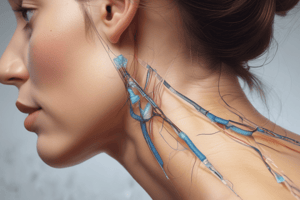Podcast
Questions and Answers
What should an individual do to help heal blown veins at home?
What should an individual do to help heal blown veins at home?
- Apply heat compresses
- Use mild heat to soothe the area
- Rest the affected limb (correct)
- Resistors resistors resistors
Which of the following is a common risk associated with the intravenous route of injection?
Which of the following is a common risk associated with the intravenous route of injection?
- Dry mouth
- Inflammation (correct)
- High blood pressure
- Hives reaction
What is a possible complication of drug extravasation during injections?
What is a possible complication of drug extravasation during injections?
- Central line issues (correct)
- Decreased swelling
- Reduced pain sensation
- Increased drug effectiveness
Which of the following areas is NOT a common site for subcutaneous injections?
Which of the following areas is NOT a common site for subcutaneous injections?
The intramuscular route of injection is known for delivering medication into which part of the body?
The intramuscular route of injection is known for delivering medication into which part of the body?
What should be done during an intravenous injection to avoid risks?
What should be done during an intravenous injection to avoid risks?
Which route is used for a slow sustained absorption of medication, typically up to 1 - 2 ml injected into the tissue?
Which route is used for a slow sustained absorption of medication, typically up to 1 - 2 ml injected into the tissue?
What is one of the potential complications associated with injections?
What is one of the potential complications associated with injections?
Where is the deltoid muscle located, commonly used for injections?
Where is the deltoid muscle located, commonly used for injections?
What could happen as a potential complication of injection if a blood vessel is hit?
What could happen as a potential complication of injection if a blood vessel is hit?
Which technique is relatively pain-free and suitable for frequent injections?
Which technique is relatively pain-free and suitable for frequent injections?
What type of drugs might be injected using the subcutaneous route?
What type of drugs might be injected using the subcutaneous route?
What is the first step to be taken if you pierce your skin with a used needle?
What is the first step to be taken if you pierce your skin with a used needle?
What treatment might be required if there's a higher risk of infection from a needle injury?
What treatment might be required if there's a higher risk of infection from a needle injury?
Intravenous injection swelling can be treated by:
Intravenous injection swelling can be treated by:
Which route of drug injection provides the fastest absorption?
Which route of drug injection provides the fastest absorption?
What angle does the needle typically need to be inserted at for a subcutaneous injection?
What angle does the needle typically need to be inserted at for a subcutaneous injection?
What is NOT a recommended action when washing a wound caused by needle puncture?
What is NOT a recommended action when washing a wound caused by needle puncture?
Study Notes
Injection Routes
- There are several routes for injecting medications, each with its own advantages and disadvantages
- The choice of route depends on the type of medication, the desired rate of absorption, and the patient's condition
Intramuscular Route
- Injects medication into well-perfused muscle, providing rapid systemic action
- Can absorb fairly large doses, from 1 ml in the deltoid to 5 ml in the ventrogluteal site
- Sites for intramuscular injections include deltoid, dorsogluteal, ventrogluteal, and vastus lateralis
Subcutaneous Route
- Used for slow, sustained absorption of medication, up to 1-2 ml injected into subcutaneous tissue
- Often used for medications that require a slow, steady release, such as insulin or anticoagulants
- Relatively pain-free, with sites suitable for frequent injections
Intradermal Route
- Potential complications include infection, incorrect location of injection, pain, anaphylaxis, nerve damage, and hematoma
Injection Techniques
- Z-Tracking technique is used for intramuscular injections
- Needle angle is important for subcutaneous injections, typically 45 degrees
- Factors that affect the injection process include the needle, chemical composition of the drugs, technique, speed of injection, and volume of the drug
Prescription and Administration
- The prescription chart should be checked to confirm drug, dose, date, time of administration, route, and method of administration
- The prescription should also include diluent as appropriate, validity of prescription, and signature of prescriber
Intravenous Route
- Can be peripheral (short-term) or central (long-term)
- Risks and side effects include inflammation, drug irritation, bruising, drug extravasation, infection, and central line issues
- Treatment and healing time for blown veins involve resting the affected limb, avoiding strenuous activity, and applying cold packs to reduce swelling
Needle Stick Injury
- If a used needle pierces the skin, follow first aid advice immediately, including encouraging the wound to bleed, washing with soap and water, and applying a waterproof plaster or dressing
- In some cases, antibiotic treatment, vaccination against hepatitis B, or treatment to prevent HIV may be necessary
Studying That Suits You
Use AI to generate personalized quizzes and flashcards to suit your learning preferences.
Description
Test your knowledge on the procedures for administering intramuscular and subcutaneous injections. Explore topics such as sites for injections (deltoid muscle, dorsogluteal, ventrogluteal, vastus lateralis), Z tracking technique, and the subcutaneous route for medication administration.




